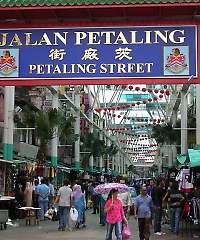Malaysia’s government wants to tear down heritage attraction, Petaling Street

By Luc Citrinot, E-Turbo News
The plan happens to come at a very unfavorable time. In recent years, Malaysia’s social fabric has turned more and more fragile due to growing tensions among its various ethnic groups. More and more citizens put into question today the fundamentals of the government’s Bumiputra policy – a 40-year-old program, which provides preferential treatment to the Malay community, asking for a review, as many look at it as ethnic discrimination. The partial destruction of Petaling Street would then deprive the Chinese community from one of its most sentimental heritage areas. The government’s decision might then be considered as more than politically incorrect.
KUALA LUMPUR, Malaysia (eTN) – No one would generally disagree with a government looking at improving public transport for the sake of commuters. Malaysia government’s latest MTR expansion is the Sg Buloh-Kalang 51 km line – to date, Malaysia’s most extensive public infrastructure with 27 elevated and 7 underground stations. It is, however, facing strong protests from residents of the areas concerned by the project. The line will connect Kuala Lumpur’s city center, passing under some of the capital city’s oldest areas, among them, Petaling Street and part of Sultan Street, two popular streets frequented by both locals and tourists. Petaling Street remains a favorite among visitors to the Malaysian capital, as it welcomes every night Kuala Lumpur’s only night market. It is also a popular place for Malaysian Chinese, especially prior to the Chinese New Year, when the community gathers to eat together and do some shopping. Petaling Street was consequently thoroughly renovated a decade ago.
The area also has a deeply historical value for the Malaysian capital. Petaling Street was, in fact, one of the first settlements for Chinese arriving into Malaya at the end of the XVIII century. The area has a high number of beautiful heritage buildings as old as 100 years. The MRT project foresees the destruction of 20 to 30 buildings, including some structures considered landmarks for Chinatown. Among them are Yook Woo Hin restaurant mentioned in many travel guides and famed for its mooncakes, as well as the Lok Ann Hotel and the Yan Keng Benevolent Dramatic Association Building. The latest is considered as the birth place to Cantonese Opera in former Malaya.
Over the last three decades, successive Malaysian government has systematically erased from Kuala Lumpur’s urban landscape any references to the city’s colonial heritage, except for a few symbolic buildings. But according to local newspapers, most shop owners were surprised to abruptly learn about the need to destroy the area to give way to the MRT. In Kuala Lumpur’s 2020 masterplan, Petaling Street has been indeed named a heritage area. But so far it has not been officially registered as such, exposing the historical district to any wild redevelopment. The surprise has even been bigger as MRT tunnels will be located 30 meters under the street and would consequently not threaten the stability of the buildings. Shop owners want now to take legal action and will ask the government to review the project to protect the area. Construction for the MRT is due to start by year-end for a projected completion in 2015.
The plan happens to come at a very unfavorable time. In recent years, Malaysia’s social fabric has turned more and more fragile due to growing tensions among its various ethnic groups. More and more citizens put into question today the fundamentals of the government’s Bumiputra policy – a 40-year-old program, which provides preferential treatment to the Malay community, asking for a review, as many look at it as ethnic discrimination. The partial destruction of Petaling Street would then deprive the Chinese community from one of its most sentimental heritage areas. The government’s decision might then be considered as more than politically incorrect.

